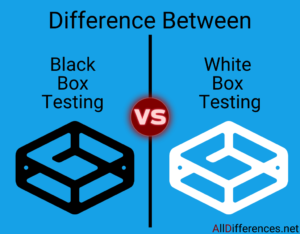Difference Between Black Box Testing and White Box Testing
Comparison Between Black Box Testing and White Box Testing

Comparison Chart
| White Box Testing | Black Box Testing |
|---|---|
| White-box testing also called as glass-box testing. It empioys the test use design concept that uses the control structures. These control structures are described as component-keel design to dense the test cases. | Black-box testing is also known as behavioural testing. It focuses only on the functional requirements of the software. |
| It guarantees the traversal of all independent paths in a module at least once. It refers the concept of traversal of tree i.e. each of the nodes in a tree must be traversed at least once. | The black-box testing helps the software developer to derive the sets of input conditions. These input conditions exercise all the functional requirements for a program. |
| It evaluates all logical decisions and finds whether they are true or false. It evaluates all the loops to check their boundaries and operational bounds. It evaluates all internal data structures to confirm their validity. | It evaluates performance errors or the behavioural errors. It evaluates missing or incorrectly defined functions. It evaluates incorrect data structures and external database errors. It evaluates errors that occurred during initialization and termination and interface errors also. |
| The white box testing begins early in the testing process. | The black box testing is applied in the final stages of testing |
| Different white box testing methods are: Basis Path Testing Control Structure Testing | Different black-box testing methods are : Graph-Based Testing Method, Equivalence Partitioning, Boundary Value Analysis. |
White Box testing
- White-box testing, sometimes called glass-box testing, is a test-case design philosophy that uses the control structure described as part of the component-level design to derive test cases.
- Using white-box testing methods, you can derive test cases that
- Guarantee that all independent paths within a module have been exercised at least once.
- Exercise all logical decisions on their true and false sides.
- Execute all loops at their boundaries and within their operational bounds.
- Exercise internal data structures to ensure their validity.
- White Box Testing method applies to the following software test levels:
- It is mainly applied to Unit testing and Integration testing
- Unit Testing: Testing the paths within a unit.
- Integration Testing: Testing the paths between units.
- System Testing: Testing the paths between subsystems.
White box testing advantages
- At an earlier stage, testing can be started. You don’t have to wait until the GUI is available.
- Testing is more thorough and most paths can be covered.
White box testing disadvantages
- Because testing can be very complex, it requires highly qualified resources with thorough programming and implementation knowledge.
- Maintenance of test scripts can be a burden if execution changes too often.
- Since this testing method is closely linked to the application being tested, it may not be readily available tools to create for any kind of implementation/platform.
Black Box Testing
- Black box testing, also known as behavioral testing, focuses on the software’s functional requirements
- That is, black-box testing techniques enable you To derive sets of conditions for inputs that fully fulfill all functional requirements. program.
- Black-box testing is no substitute for white-box testing. Rather, it is a complementary approach that is likely to reveal a different error class than white-box methods.
- Black Box Testing method applies to the following software testing levels:
- It is mainly applied to System testing and Acceptance testing
- Integration Testing
- System Testing
- Acceptance Testing
- The higher the level, and hence the larger and more complex the box, the more use is made of the black box test method.
Black box testing advantage
- Tests are passed out from the point of view of a user and will help to identify discrepancies in the specifications.
- Tester does not need to know programming languages or how to implement the software
- Tests can be performed by a developer-independent body, allowing for an objective perspective and avoidance of developer-bias.
- Once the specifications are complete, test cases can be designed.
Black box testing disadvantages
- Only a small number of possible inputs are possible to be tested and there will be many program paths left untested.
- Test cases will be difficult to design without clear specifications, which is the situation in many projects.
- Testing can be redundant if a test case has already been run by the software designer/developer.
